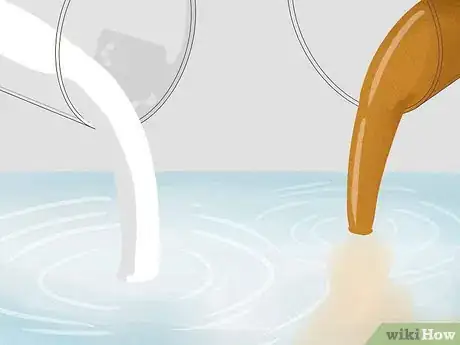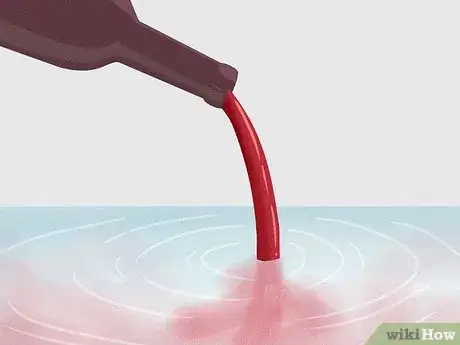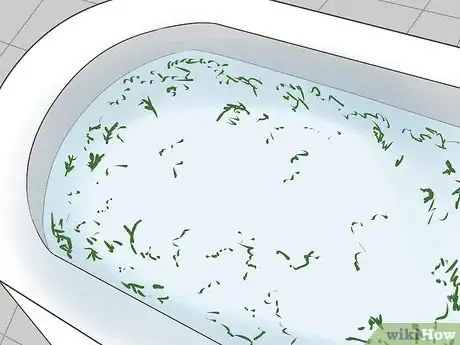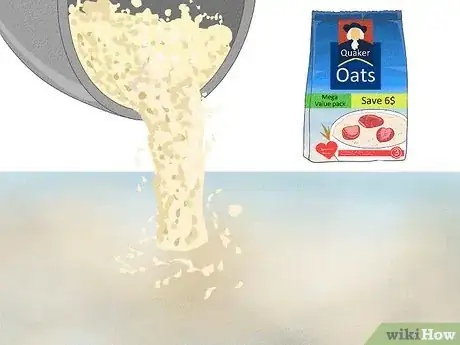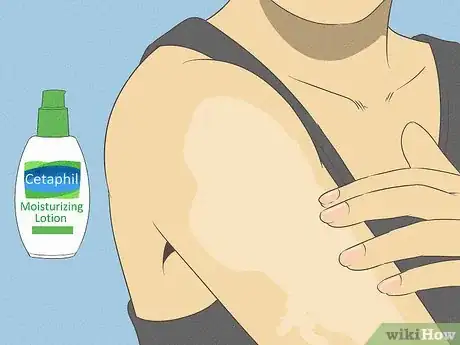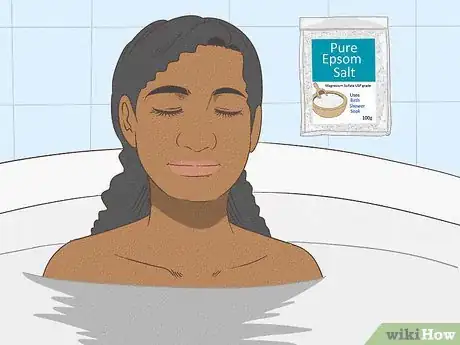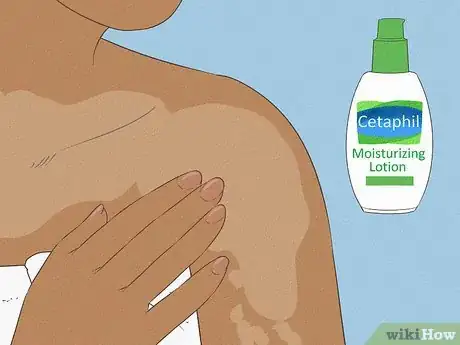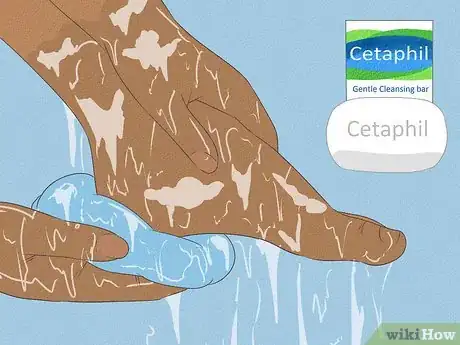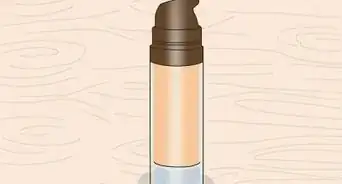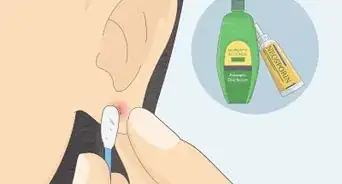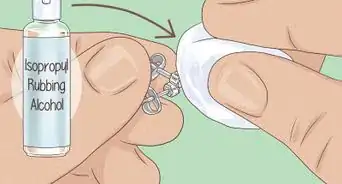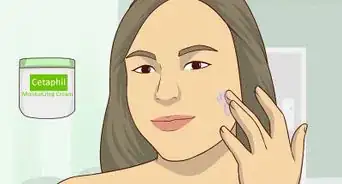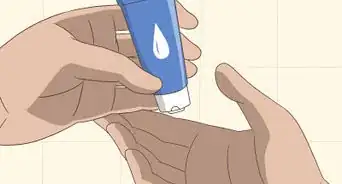This article was co-authored by Indy Chabra, MD, PhD. Dr. Indy Chabra is a Board Certified Dermatologist and a Board Certified Mohs Micrographic Surgeon. He is the Founding Member of DMC Dermatology & Mohs based in Tucson, Arizona. With over 15 years of experience, he provides medical, surgical, and cosmetic dermatology care for adult and pediatric patients. Dr. Chabra earned a BS in Chemistry and Biological Sciences and an AB in Economics from Stanford University. He also received his MD and PhD in Microbiology and Genetics from Stony Brook University. He completed his Dermatology residency at the University of Pittsburgh Medical Center (UPMC), Pittsburgh. While at UPMC, Dr. Chabra received extensive training in complex Medical Dermatology, hair and nail conditions, Pediatric Dermatology, Cosmetic Dermatology, and Mohs Skin Cancer Surgery. Dr. Chabra is a Fellow of the American Society for Mohs Surgery, a Fellow of the American Academy of Dermatology, and a Fellow of the American Society for Dermatologic Surgery. Dr. Chabra also provides in-patient Dermatology consults at Tucson Medical Center.
wikiHow marks an article as reader-approved once it receives enough positive feedback. In this case, several readers have written to tell us that this article was helpful to them, earning it our reader-approved status.
This article has been viewed 552,678 times.
Everyone wants to have smooth baby soft skin. There are a variety of methods you can use to help you skin stay soft and beautiful.
Steps
Using Kitchen Supplies
-
1Figure out the proper way to soak. When soaking in a bath to moisturize your skin, remember to limit your exposure to water to 20 minutes. Any longer could dry out your skin. Keep water lukewarm. Hot water can cause skin to peel and flake.
-
2Try milk and honey. Milk contains lactate, which has exfoliating properties, and honey has softening, moisturizing properties. Soaking in a milk and honey bath can help improve the quality of your skin.
- Use full fat milk or powdered milk and pure honey. Full fat milk can help moisturize the skin as well as helping to exfoliate.[1]
- Pour 1 to 2 cups of milk and half a cup of honey under warm, running water and wait for the tub to fill. Mix the milk and honey into the water until the mixture if uniformed throughout.[2]
- Get in the bath and soak for as long as you feel comfortable. Once you get out, gently pat your skin dry.[3]
Advertisement -
3Use champagne or red wine. While extensive research is lacking, many celebrities and beauty enthusiasts claim they notice their skin becoming softer, lighter, and younger looking when they soak in red wine or champagne. This may be due to antioxidants in red wine and tartaric acid in champagne, both of which can potentially lighten skin.[4]
- Pour a glass of wine or champagne in a running bath. Mix the alcohol into the water and climb into the tub. Soak for about 20 minutes.[5]
- Many feel soaking in alcohol is a waste of money, but the good news is the effects will be the same if you use champagne that's gone flat or wine that's turned bad. If you have any old alcohol sitting around, you could use it for a bath rather than letting it go to waste.[6]
-
4Use herbs. A variety of herbs and spices, some of which you probably have in your kitchen right now, can be used in a bath to revitalize skin. If you have any spices you don't frequently use, try throwing them into a bath.
- Sage, rosemary, peppermint, chamomile, and green tea have a positive effect on the skin for some. The scents of these herbs can also be calming, if you're looking for a bath as a means to wind down.[7]
- You can either sprinkle herbs into your tea are brew a herbal tea ahead of time. Take one to two cups of your tea and add it to your bathwater. Any excess herbs should be removed from the tea kettle and placed in a washcloth. Tie the top of the washcloth together and leave it in the bath while you soak.[8]
-
5Take an oatmeal bath. Oatmeal baths are a very popular method to treat dry skin. Oatmeal can sooth dry and itchy skin and also helps moisturize skin.
- For an oatmeal bath, either use colloidal oatmeal or run a few cups of regular oatmeal through a food processor. This will mix better with the bathwater.[9]
- You can also add baking powder, coconut milk, or olive oil for added softness.[10]
- Mix the oatmeal and any other ingredients you're using into a warm bath. Stir until dissolved and then hop in. Soak for 20 minutes and, when you're done, gently pat your skin dry.[11]
-
6Moisturize after your bath. Once you get out of a bath, use your regular moisturizer on your legs, arms, shoulders, and face. This will make the effects of the soak last longer and replenish any oils lost through the bathing process.
Using Epsom Salt
-
1Take a bath with epsom salt. Epsom salt is not actually salt but a naturally occurring mineral compound. It has a number of health benefits, including moisturizing and rejuvenating dry, cracked skin. You can take a bath using epsom salt if you want better skin.[12]
- Add 2 cups of epsom salt to a warm bath and let the salt dissolve. Do not add any soap or other beauty products as it can interfere with the salt.[13]
- Soak in the water for at least 12 minutes. When you get out of the tub, gently pat your skin dry using a towel.[14]
- For optimal results, try to bathe in epsom salt three times each week.[15]
-
2Exfoliate your skin. You can also use epsom salt to exfoliate your skin. Exfoliation is a process by which dead skin and debris are removed. Many people exfoliate their faces on a regular basis to keep skin clear and prevent acne.
- While taking a shower or bath, mix epsom salt in with bath gel or shampoo and rub the mixture over rough patches of skin like the elbows and knees. Rinse thoroughly.[16]
- If you want to exfoliate your face, mix in half a teaspoon of epsom salt in with your regular cleansing cream and then use as usual.[17]
-
3Add baby oil or olive oil to epsom salt mixtures. If your skin is particularly dry, try adding baby oil or olive oil to epsom salt mixtures. These oils can help moisturize dry skin. Add a few drops of baby or olive oil to an exfoliating mixture or half a cup to an epsom salt bath.[18]
-
4Moisturize. When you finish using epsom salt, always moisturize. Using a quality lotion can replenish any oils lost from the exposure to water. While epsom salt is good for the skin, it can easily dry out your skin during the exfoliation process.
- Look for lotions that are hypoallergenic and noncomedogenic if you have sensitive skin or are prone to acne breakouts.
Caring for Dry Feet
-
1Wash your feet each day with warm water and soap. Many people worry about dry, cracked feet. The skin on your feet is easily damaged due to day-to-day walking and one of the simplest ways to manage dry feet is washing them each day with warm water and soap.
-
2Exfoliate your feet. Dry feet can definitely benefit from an exfoliation process. Exfoliating your feet a few times a week can help them stay smooth and clean.
- Many beauty stores and drug stores sell exfoliation creams specifically designed for foot care. If you choose this route, simply follow the directions on the package.
- You can also use epsom salt. Add half a cup of epsom salt to a basin of lukewarm water and soak your feet for 20 minutes. Dry your feet and then add two drops of peppermint oil to your usual moisturizer and rub that into your feet.
- If your feet are particularly cracked or dry, consider buying a pumice stone or callous shaver. These are loofah-like devices designed to help loosen dead skin from difficult areas like the heels, between the toes, and ankles.
-
3Moisturize daily. Another simple way to keep your feet soft is to simply moisturize each day. Simply apply your normal moisturize to your feet after a shower. You may also want to buy a cream specifically designed for feet from a beauty or department store. Pay attention to areas like your heals and between the toes, as these areas tend to dry out most easily.[21]
Community Q&A
-
QuestionWhat can I do to get soft skin?
 Community AnswerHoney, oats, or milk baths. Also regular things like moisturizing and exfoliating.
Community AnswerHoney, oats, or milk baths. Also regular things like moisturizing and exfoliating. -
QuestionWill this help with acne?
 Medha SaggurtiCommunity AnswerNo, this will not help with acne. The best way to help acne is to simply wash your face with cleanser and water. If you have a severe case, see a dermatologist.
Medha SaggurtiCommunity AnswerNo, this will not help with acne. The best way to help acne is to simply wash your face with cleanser and water. If you have a severe case, see a dermatologist. -
QuestionMy skin becomes dry even after I use moisturizer. What should I do?
 Community AnswerTry a different moisturizer. They are not all equally effective. Make sure to exfoliate regularly to help remove dry, dead skin and help your products soak in better. Add a thin layer of an oil such as argan oil on top of your moisturizer if you need extra moisture.
Community AnswerTry a different moisturizer. They are not all equally effective. Make sure to exfoliate regularly to help remove dry, dead skin and help your products soak in better. Add a thin layer of an oil such as argan oil on top of your moisturizer if you need extra moisture.
References
- ↑ http://www.newhealthguide.org/Honey-For-Face.html
- ↑ http://www.crunchybetty.com/5-relaxing-rejuvenating-bath-recipes-perfect-alternatives-to-bubbles
- ↑ http://www.crunchybetty.com/5-relaxing-rejuvenating-bath-recipes-perfect-alternatives-to-bubbles
- ↑ http://www.crunchybetty.com/5-relaxing-rejuvenating-bath-recipes-perfect-alternatives-to-bubbles
- ↑ http://www.crunchybetty.com/5-relaxing-rejuvenating-bath-recipes-perfect-alternatives-to-bubbles
- ↑ http://www.crunchybetty.com/5-relaxing-rejuvenating-bath-recipes-perfect-alternatives-to-bubbles
- ↑ http://www.foxnews.com/health/2011/05/24/great-herbs-skin/
- ↑ http://www.crunchybetty.com/5-relaxing-rejuvenating-bath-recipes-perfect-alternatives-to-bubbles
- ↑ http://herbalacademyofne.com/2015/03/soothing-oatmeal-bath-recipe/
- ↑ http://herbalacademyofne.com/2015/03/soothing-oatmeal-bath-recipe/
- ↑ http://herbalacademyofne.com/2015/03/soothing-oatmeal-bath-recipe/
- ↑ http://www.saltworks.us/salt_info/epsom-uses-benefits.asp
- ↑ http://www.saltworks.us/salt_info/epsom-uses-benefits.asp
- ↑ http://www.saltworks.us/salt_info/epsom-uses-benefits.asp
- ↑ http://www.saltworks.us/salt_info/epsom-uses-benefits.asp
- ↑ http://www.saltworks.us/salt_info/epsom-uses-benefits.asp
- ↑ http://www.saltworks.us/salt_info/epsom-uses-benefits.asp
- ↑ http://www.saltworks.us/salt_info/epsom-uses-benefits.asp
- ↑ http://mcdermottfootcare.com/2012/01/28/8-tips-for-dry-cracked-heels/
- ↑ http://mcdermottfootcare.com/2012/01/28/8-tips-for-dry-cracked-heels/
- ↑ http://mcdermottfootcare.com/2012/01/28/8-tips-for-dry-cracked-heels/

